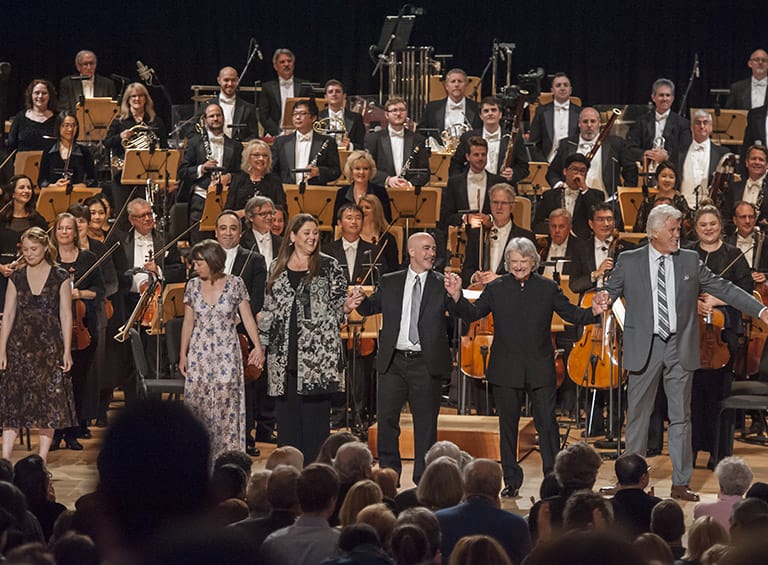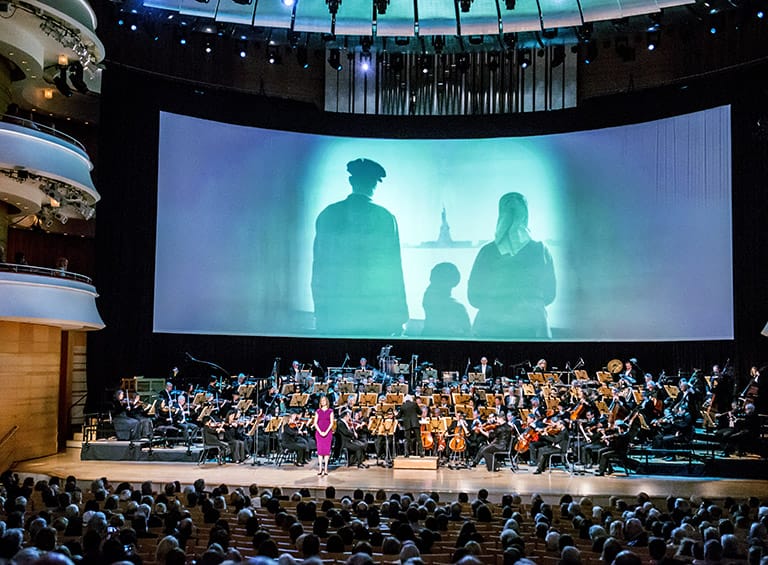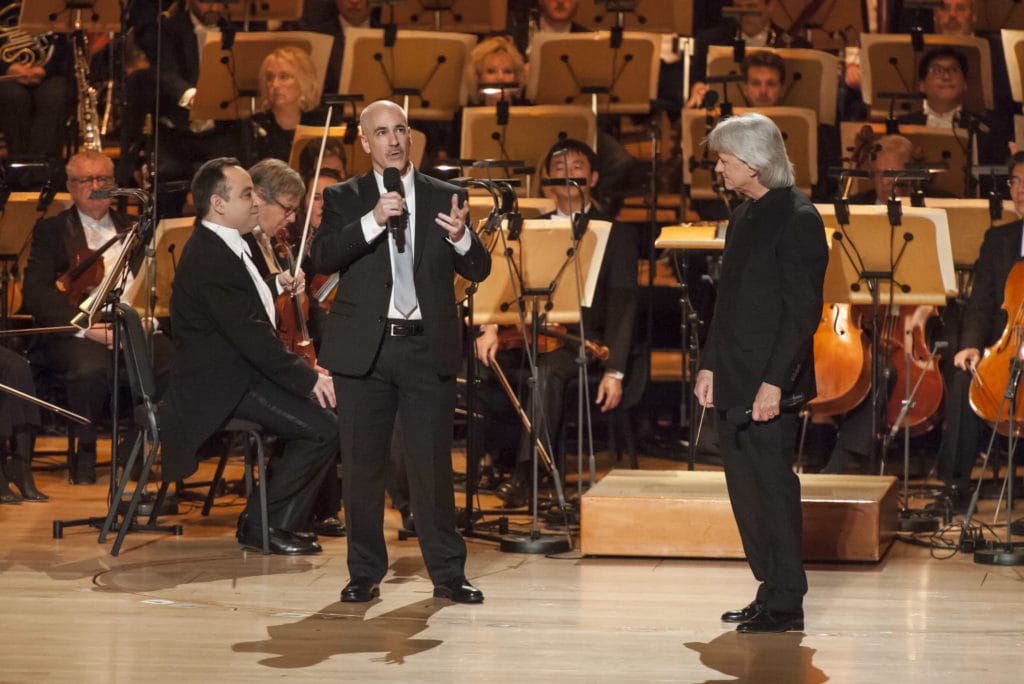Gateway to America: With its PBS Debut, Peter Boyer’s “Ellis Island” Marks a Milestone

By Scott Timberg
Most of composer Peter Boyer’s life involves working with music, not words. But years ago, when he was a decade or so into his career, putting together a piece about Ellis Island, he took a full five months to dig into oral histories—pure language, with no notes or chords attached.
“One of the women in my research described staying on the boat for six days, in New York harbor, with only bread and water,” recalls Boyer, a Grammy-nominated orchestral composer who holds the Helen M. Smith Chair in Music at Claremont Graduate University. An Italian woman who arrived at Ellis Island as a child spoke about being reunited with a father whose voyage had preceded hers.
And he remembers a man who described America as the only country where you’re not a stranger, because we’re all strangers here.
Some spoke of the grandeur of the Statue of Liberty they could see from their ship’s deck, or the optimism they felt arriving in the United States, or their ambiguity about having left roots on one continent to be transplanted, like a tree, on another.
The words of these immigrants from Europe inspired a piece that went on to a long life after its initial performance: At the end of June, Ellis Island: The Dream of America, in a performance with Orange County’s Pacific Symphony, was broadcast on PBS as part of its Great Performances series, an honor given to very few pieces of contemporary music. The work—presented near the end of Immigrant Heritage Month—was seen on television by even more than the many who’ve experienced it in nearly 200 live performances around the United States over the past 16 years.
****

In an era some music historians have described as post-classical, few composers establish themselves through conventional means. But Boyer’s path is both more and less conventional than most.
There was little classical music in Boyer’s life growing up in Providence, Rhode Island, in the ’70s and early ’80s. But his mother—a teacher who was active in theater—played Stephen Sondheim show tunes around the house. At age 15, Boyer decided he wanted to learn to play piano and write music, without a firm sense of what either meant. His grandmother, with whom he was very close, bought him an instrument, and he dedicated himself to it.
Two years later, while Boyer was studying music history in high school, his grandmother died. Though Boyer had had no formal lessons in composition, he decided to write a piece—inspired by Mozart’s Requiem—for a woman who’d allowed him to blossom as a musician.
Over the next few years, which involved graduating early from high school and attending Rhode Island College, Boyer listened to every recording he could find of a requiem—the term refers to a mass for the dead—at the public library. He studied scores. He wrote a piece, orchestrated it, and raised $20,000 for its performance, making numerous connections and alliances along the way.
The ensuing piece—performed with nearly 200 singers and a 90-piece orchestra in a sold-out concert—landed Boyer on the cover of a special section of USA Today while he was still an undergraduate.
As successful as the requiem was, Boyer had only begun his journey as a composer. Master’s and doctoral degrees from the University of Hartford’s Hartt School, private study with renowned composer John Corigliano, and a graduate certificate in film and TV scoring from the University of Southern California Thornton School of Music awaited.
****

Boyer has composed more than 20 orchestral works, many of which have been performed around the United States, and broadcast all over the world. His 2010 work, The Dream Lives On: A Portrait of the Kennedy Brothers, enlisted Robert De Niro, Morgan Freeman, and Ed Harris in its tribute to John, Robert, and Edward Kennedy, respectively. Boyer’s Silver Fanfare opened the Hollywood Bowl’s seasons from 2015 to 2017. Before all this, barely 30, he conducted the London Symphony Orchestra at Abbey Road Studios.
But Ellis Island has been by far his defining work, at least so far; it’s the piece his audiences are most likely to hear about and see performed.
The piece, which has taken on a political resonance lately, emerged in an era when immigration was far less controversial. Boyer, like a lot of Americans, had a strong sense that Ellis Island was an important part of the American story, but it was not clear to him that it had a direct reference to his own. This was not a voyage of personal discovery, but rather a burrowing into what he saw as a central part of American mythology.
Boyer had been interested in a more familiar kind of mythology—Greek and Roman—for a long time, composing pieces on that subject matter; and another early piece of his was about the Titanic, some of whose passengers would have entered the United States at Ellis Island if they had made it.
“I wanted to tackle some American subject matter of consequence,” he says, in part because his own compositional instincts were drawing from a homegrown tradition that included the work of Aaron Copland.
At the time, the passenger records of Ellis Island immigrants had recently been released online. Ellis Island received 12 million immigrants, especially those from eastern and southern Europe, from 1892 to 1954. After Hartford’s Bushnell Center for the Performing Arts commissioned the piece, Boyer dove into the Ellis Island Oral History Project—sitting in a huge room on the island and digging into more than 100 lives—and was amazed at the scale of it. “It’s incredible,” he says now. “In 1907 or so there were 6,000 [immigrants] a day getting processed—a staggering number of people.”
And while Ellis Island opens and closes with orchestral music, the voices—spoken by actors like Eli Wallach and Bebe Neuwirth on the Grammy-nominated Naxos recording—were crucial to the piece’s structure. “The task became how to create a script that was compelling, had a diversity of voices, and provided an overall architecture for the piece.”
It was only later, in his research, that Boyer learned that some of his Italian ancestors had entered the country through this legendary portal.
****
All through his career—before and after Ellis Island—Boyer has been driven by a sense that classical music can speak to a broad audience, and that it can be American in its orientation. “We’re all products of our influences,” he says. “And if you’re a composer, you’re in this very long line. But I became a lover of a lot of American repertoire.” Besides Copland, he considers Leonard Bernstein and John Williams among his key influences.
Something all three have in common is their ability to write genuinely popular orchestral music. “Contemporary classical music has had a reputation for being daunting, something to be endured.” But his music not only engages with big topics, it reaches audiences emotionally. “I believe in the communicative power of melody.”
It’s a spirit he tries to bring to his students at CGU, where he teaches composition as well as a 20th- and 21st-century music class, American film music, and a course on Bernstein and Copland, American Titans.
In a sense, an American composer of classical music is an analog to the immigrants who came to the United States through Ellis Island: His tradition was born elsewhere, but it has arrived on fresh ground. “We live in a time when the subject of immigration has become especially controversial,” he says. “I see Ellis Island as an optimistic statement, a celebration of a very important period in our history—a gateway to America.”